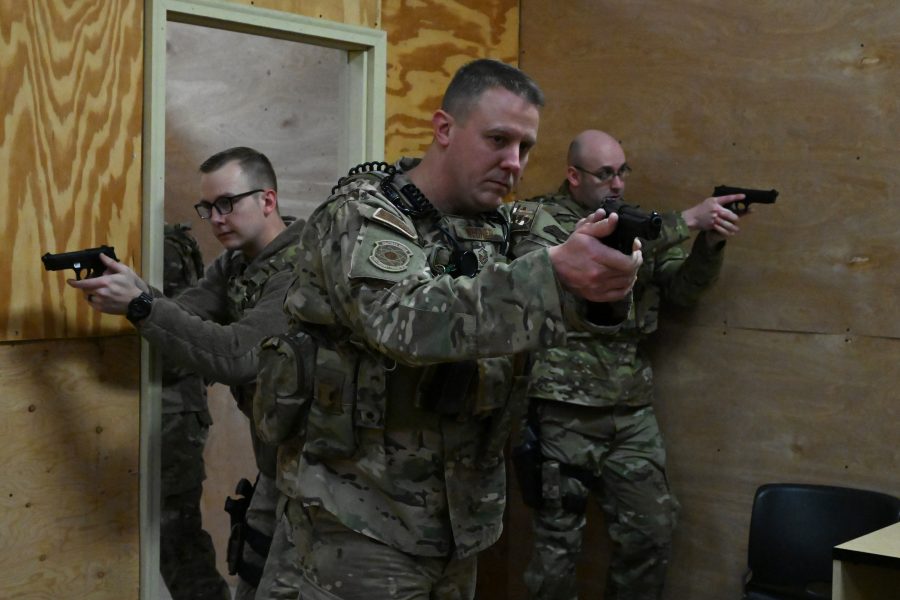After a British man eluded security at RAF Mildenhall, England, in 2017 and rammed an aircraft on the flightline with his car, the Air Force launched its Reconstitute Defender Initiative to ensure the 38,000 Airmen standing guard across 120 military bases around the world had the training, equipment, and esprit de corps they needed to get the job done.
In all, the service identified 900 action items to improve security, the last of which was recently completed, said Lt. Gen. Warren D. Berry, the Air Force’s deputy chief of staff for logistics, engineering, and force protection, at an online Mitchell Institute for Aerospace Studies event July 9.
More must still be done to institutionalize changes like mandatory time off, and to adapt to evolving base defense needs, but progress has been made, he said.
The Air Force is spending over $180 million to upgrade equipment, according to Air Force Chief of Staff Gen. David L. Goldfein. For example, the M9 Beretta has been replaced by the more accurate Sig Sauer M18 pistol and defenders are getting the Heckler & Koch M320 grenade launcher and better precision rifles. The Army’s Joint Light Tactical Vehicle is replacing aging Humvees, with the first ones going to training locations and bases that handle nuclear weapons and aircraft.
The service’s first-ever female body armor is coming online, as well as new ballistic helmets and vests, Berry said. And research is underway on new technologies to help defend bases, he added without offering details. That could include directed-energy weapons to fend off small drones and cruise missiles.
Sometimes, improvements are as simple as digitizing records and helping Airmen to reach for their weapon more rapidly. “You would have to shove stuff aside to get the right guns out or fight with the locker system,” Senior Airman Cory Loicao, 627th Security Forces Squadron flight armorer at Joint Base Lewis-McChord, Wash., said in a release. “With this new system, it has taken it down to [less than five minutes] per person.”
USAF has also tried to instill a greater sense of duty and honor in security forces culture, Berry said. “It means something to wear the beret.”
Defenders are ramping up training in small-unit tactics and law enforcement, and moving toward greater proficiency and muscle memory instead of simply qualifying for the job. Officials are pushing more regular training, and Goldfein has said security forces should be practicing marksmanship daily.
The Air Force also wants new communications equipment for security Airmen. Better connected Defenders will be able to react faster to breaches and problems. “The threat is outside the wire right now,” Goldfein said last fall. “They are sizing us up, looking for weaknesses in our lines. What we want them to determine is that we are just too hard a target to penetrate.”
Fourteen security forces squadrons began a “Squadron of the Future” project last year, including embedding trainers in every flight and increasing training from four to six days per month.
“Previously when we had to go to training, people generally [dragged] their feet,” Tech. Sgt. Corey Southard, 422nd Security Forces Squadron noncommissioned officer in charge of training at RAF Croughton, England, said in a December 2019 release. “Now you have a trainer embedded amongst your flight. People are more receptive to it. … The quicker they train you, the quicker you get out or go off to bigger and better things.”
Berry said the Air Force still has unfunded security forces positions to fill, but leaders are comfortable with the personnel they have. He did not say how many of those jobs are vacant.
An ongoing facilities overhaul plan will likely change what the Air Force needs from its security forces. Protecting against small drones is one growing mission security forces face, Berry said.
“We are preparing for a future that will look significantly different than our past,” the Air Force Security Forces Center said. “The future is full of frequent disruption, not just from technology, but also from people and leaders who are looking to do things better, more fairly, and more responsibly.”
